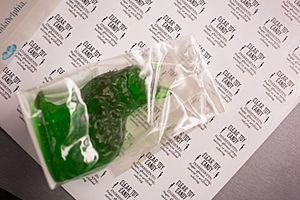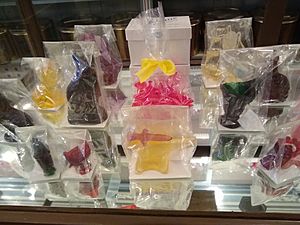Clear toy candy facts for kids
Clear toy candy is a traditional sweet treat. It first became popular in countries like Germany, England, and Scotland. People especially love to enjoy it during Easter and Christmas. This hard candy is made using special molds, which give it many fun and fancy shapes. The candy usually comes in bright colors like yellow, red, and green. Sometimes, a stick is added before the candy cools completely, turning it into a lollipop.
The names "clear toy candy" and barley sugar are sometimes used for the same type of clear molded sugar candy. However, traditional barley sugar is made with barley water, while clear toy candy is made with pure water. Unmolded barley sugar started in France in the 1700s. Molded sugar candy, like clear toy candy, came later in the 1800s. The term "barley sugar" became a general name for many boiled sugar candies during the 1800s, which is why it can be confusing.
How Clear Toy Candy is Made
Traditional recipes for clear toy candy usually include sugar, cream of tartar (a common baking ingredient) or corn syrup, and water. When the candy cools, its natural color is yellow. Sometimes, natural food coloring is added to make it red or green.
To stop the candy from sticking, the molds are greased with olive oil. The candy is removed from the mold while it is still a little soft. This helps prevent it from breaking. Any rough edges are then smoothed out. Clear toy candy was often made in colder weather. This is because heat and humidity can make the candy cloudy and sticky as it cools.
An old cookbook from Chicago in 1883 even has a recipe for molded clear toy candy, called "Candy for Christmas Toys, Etc." A modern recipe for clear toy candy has also been shared by Nancy Fasolt.
The pictures below show how clear toy candy is made. They were taken at a candy-making event by Ryan Berley of Shane Confectionery in Philadelphia. You can see the molds being prepared, filled, and opened to take out the cooled candy.
Candy Makers and Their History
Clear toy candy started in Germany, Great Britain, and Scotland. In Germany, it was sometimes called roter zuckerhase, which means "red sugar hare."
Many clear toy candy makers have been family businesses. One of the first in North America was William Daw Startup. He learned candy making from his father in England. William and his wife Hagar started the Startup Candy Factory in Provo, Utah, in 1875. After William passed away, his wife and children continued the business.
German settlers brought clear toy candy to the Philadelphia, Pennsylvania area of North America. A busy candy-making industry grew around Philadelphia because it was a major center for the sugar trade.
Regennas Candy was founded in 1894 by C. Fred Regennas. His children later continued the business. Regennas first sold candy from a horse-drawn wagon in Philadelphia before moving to Lititz, Pennsylvania.
Young's Candies of Philadelphia was started by Johan Jung (later known as John Young) in 1897. This was also a family business. Harry Young Jr. ran it from the 1940s until he passed away in 2007. Many of Harry Young's clear toy candy molds were sold to the Berley brothers. They took over Shane Confectionery in 2010. Shane Confectionery still makes and sells clear toy candy for Easter and Christmas.
Maggie Wolfgang started Wolfgang Candy in York, Pennsylvania, in 1918. She designed many of the patterns for her molds. Wolfgang Candy sold directly to customers until 2018. Now, it mainly sells to other businesses as Wolfgang Confectionery.
Shelly Brothers of Souderton, Pennsylvania, started in the 1930s. They made clear toy candy until 1990 when they were bought by the Brock Candy Company (later Brach's).
Albert Dudrear of York, Pennsylvania, was a clear toy candy maker and a big collector of molds. His son-in-law, Donald Culp, continued selling Original Clear Toy Candy after him.
Clear toy candy is also found in Atlantic Canada. It appeared there as early as the 1880s. Robertson's Candy, founded in Truro, Nova Scotia, in 1928, still makes traditional clear toy candy at Christmas time.
Molds for Candy Making
Molds for clear toy candy were traditionally made from different metals. These included an alloy (a mix of metals) of tin and zinc called "composition," iron, aluminum, lead, or pewter. Today, we know that lead and pewter are not safe if they are eaten. So, these materials should not be used for making candy molds anymore. Composition molds are often thought to be the best for candy making because they can create very detailed shapes.
Valentine Clad came from Alsace, France, to Philadelphia and opened a business in 1853. He made cooking and candy-making tools, including clear toy candy molds from iron. His sons joined the business in 1892, and they became V. Clad & Sons in 1896.
Thomas Mills and his brother George came to Philadelphia from Melrose, Scotland, in 1864. Like Clad, they made cooking and candy-making equipment. However, Thos. Mills & Bro. used composition (a mix of tin and zinc) for their clear toy candy molds. They also made pattern molds from brass or bronze. These patterns were used to create the actual candy molds. Candy molds were made in two halves that fit tightly together. They usually had the maker's name and sometimes a patent number. At one point, there was so much demand that Mills hired Clad to make composition molds. These molds might have both company names, one on each side. Mills sold their molds in sets of fifty. Each mold could make one or more clear toy candies, depending on its size. Leonhard Schulze and Karl Hohnstock were two mold designers who worked for Mills before it closed in 1946.
Other American mold makers included Thos. J. Andress & Co. of Philadelphia, who made molds for the Centennial Exposition in 1876. There were also Crandall & Godley of New York and Kiddie Kandie. Around 1990, the John Wright Company made some small molds with a non-stick coating. Before its owner, Nancy Fasolt, passed away in 2015, Cake and Kandy Emporium of East Petersburg, Pennsylvania, made reproduction molds.
In Canada, J. Therien of Montreal and Fletcher Manufacturing in Toronto made molds. Molds were also made by G. Lieb in Stuttgart, Germany, between 1868 and 1960.
During World War II, many candy molds were melted down to be used as scrap metal.









